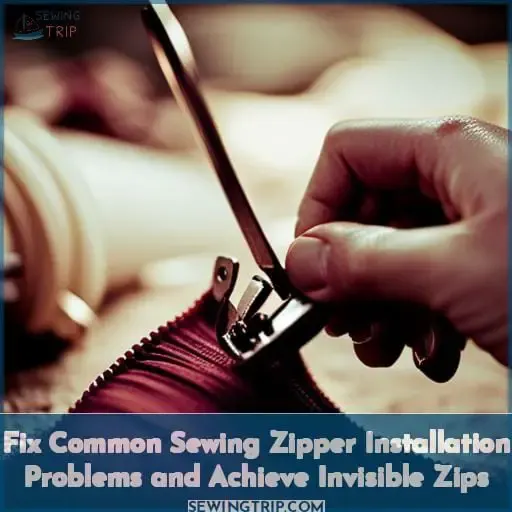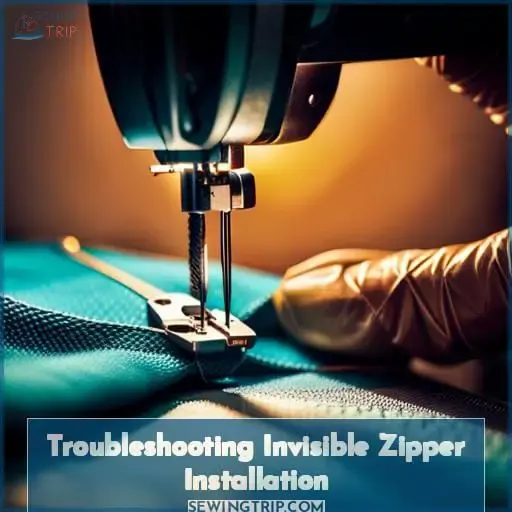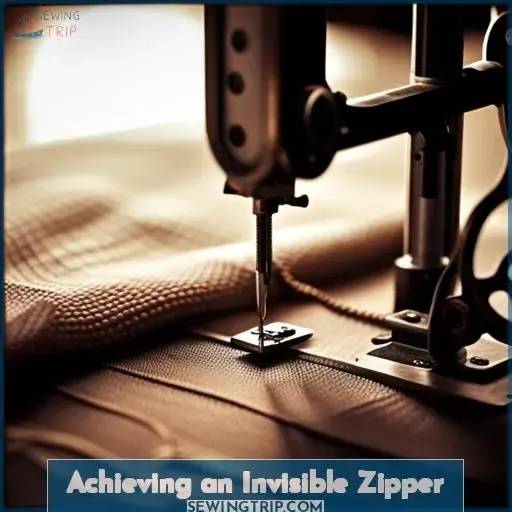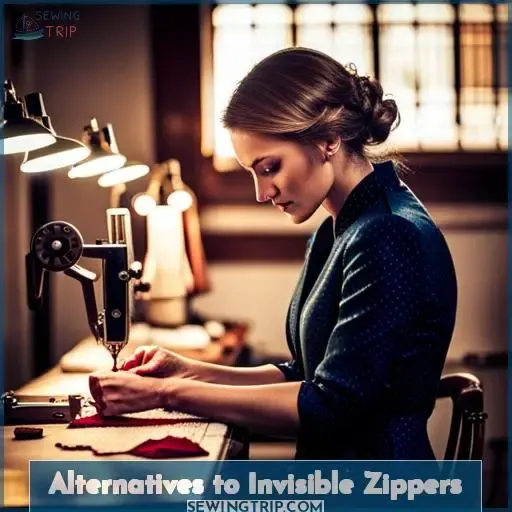This site is supported by our readers. We may earn a commission, at no cost to you, if you purchase through links.

Yet that smoothly gliding teeth-lined gateway promises effortless dressing.
Master proper installation and even temperamental fabrics become cooperative.
Let delicate invisible zips whisper while sturdy skirts shout “ziiiip!”
Test on scraps first, then follow specialized tricks.
Soon you’ll fix common zipper problems for good.
Table Of Contents
Key Takeaways
- Adjust the needle position to evenly catch zipper teeth when using a zipper or walking foot.
- Check your machine’s capabilities and test techniques on scraps before sewing zippers on your final fabric.
- Pivot and precisely follow the zipper coils, especially on lightweight or unforgiving fabrics.
- Play around with settings like stitch length on sample fabrics first to optimize your machine’s zipper sewing.
Troubleshooting Invisible Zipper Installation
When installing invisible zippers, you may encounter problems like wavy fabric or inadequate needle position adjustment.
These issues make achieving truly invisible results difficult.
Stay calm and try the troubleshooting tips below to resolve them:
- Wavy fabric: Ensure the zipper is sewn in straight lines and that the fabric is taut.
- Inadequate needle position adjustment: Adjust the needle position so that it catches the zipper teeth evenly.
Wavy Fabric
Don’t let uneven fabric waves deter you when installing an invisible zipper.
Carefully press the fabric before sewing to remove wrinkles and waves.
Ensure proper zipper alignment by carefully pinning or using adhesive tape to hold it in place.
Take your time and stitch slowly, carefully guiding the fabric under the needle to prevent waves from forming.
Check zipper alignment often, and make small adjustments as needed.
For extra insurance, consider finishing the zipper seam allowance with a zigzag or overlock stitch to control stretching.
A bit of patience and precision prevents frustration when conquering common zipper problems for beautifully smooth, flawless results.
Inadequate Needle Position
However, if your machine can’t adequately adjust the needle position, you’ll struggle to sew close enough to the zipper teeth to make it invisible.
Without precise needle positioning, the stitches can wander and your efforts to conceal the zipper will fail.
- You’ll be frustrated when the zipper shows through the fabric.
- The dress fit will suffer without an invisible zip installation.
- All your hard work making the dresses could seem wasted.
Considering your machine’s capabilities and testing on scraps first can help avoid disappointment.
If needle precision proves impossible, reconsider alternatives like centered regular zippers for these dresses.
The right zipper style, paired with careful alignment, pressing, and stitching, can still result in a professional finish.
Discuss options with the bride rather than risk problems fitting the dresses later.
Achieving an Invisible Zipper
For optimal results in attaining invisible zippers, you’ll need to carefully press the seam allowances.
With an invisible zipper foot installed, position the zipper coils close to the fabric edge without exposing teeth.
Choose lightweight, flexible fabrics with some give, assessing compatibility by testing samples first.
As you stitch, pivot the fabric to follow the zipper coils precisely, keeping an even gap between stitches and coils.
If fabric still ripples, consider switching to a centered zipper with contrasting tape as a decorative detail instead.
Whether troubleshooting a stuck zipper or aiming for that invisible look, taking time to prepare materials properly and hone technique makes all the difference.
Experiment with tension and stitch length until achieving neat, uniform stitches.
With practice, patience, and the right supplies, invisible zips can elevate any garment beautifully.
Working With Delicate, Unforgiving Fabrics
Frequently, when working with delicate, unforgiving fabrics like silk or satin, you’ll want to test any zipper techniques on scrap fabric samples first.
These materials can be destroyed by a single pulled stitch, so precision is key.
Handling the fabric gently, avoid stretching or distorting it when pinning the zipper in place.
Ensure perfect alignment, then take your time guiding the fabric under the needle with total control.
If possible, choose a zipper foot that allows needle position adjustments, bringing the stitching dangerously close for that invisible look.
Check for skipped stitches or damage after every few inches.
Make micro adjustments as needed to prevent snags.
Fit as you go, allowing just enough ease so the zipper glides smoothly without catching.
With practice on scraps and patience during the actual sewing, even the most delicate fabrics can have that magical invisible zipper you desire.
The results will be worth the care taken.
Testing Techniques on Sample Fabrics First
While working with delicate or unforgiving fabrics can be challenging, you’ll find that testing your zipper techniques on sample fabrics first allows you to perfect your skills without damage.
Before installing an invisible zipper in your bridesmaid dress made of stretch twill, cut some fabric scraps from your stash in a similar weight and texture.
Play around with stitch length, needle position, tension, and zipper insertion using your invisible zipper foot on these practice pieces.
Make adjustments and do trial runs until you achieve smooth, flawless results.
Experiment to determine the optimal settings and methods for your machine.
The beauty of working with samples is that mistakes don’t matter – you can rip out imperfect stitches and try again without pressure.
Once comfortable with the process, you’ll be ready to neatly install that invisible zipper in the real bridesmaid dresses.
By taking the time to test beforehand, you’ll gain confidence and avoid potential disasters.
Invisible zipper success requires diligent practice using substitute fabrics.
Alternatives to Invisible Zippers
Watching your invisible zipper veering off course and causing waviness in delicate fabrics is beyond frustrating.
But don’t give up on achieving that discreet closure just yet.
Alternatives to invisible zippers provide other creative solutions that achieve a smooth, professional finish.
- Decorative fasteners like ribbon ties, lace inserts, or hook and eye closures add visual interest while masking the zipper.
- Button closures spaced strategically down the back seam elegantly hide the zipper under a row of buttons.
- Experiment with these and other decorative touches tailored to your fabric and style to make your zipper disappear into the design.
With patience and creativity, you can conquer the invisible zipper and find solutions that do your sewing justice.
Frequently Asked Questions (FAQs)
What type of thread works best for installing invisible zippers?
Try polyester or nylon thread when installing invisible zippers.
These smooth threads move easily through the coils and don’t get caught.
Use a matching thread color so stitches blend in seamlessly.
Test your thread and tension settings first before sewing the final garment.
A lightweight thread is key for an invisible zipper.
Are there any specific tools that make invisible zippers easier to install?
Try using a zipper filament to help you apply the zipper evenly.
Pliers and shears are also handy for trimming extra fabric and bringing the seam very close.
Fusible tape and pins can help align the seam so the zipper glides smoothly.
With the right tools, invisible zippers become much more manageable.
How can I prepare the fabric along the zipper opening to prevent stretching or distortion?
Interface the zipper area to add body and stability.
Staystitch the zipper opening’s raw edges to reinforce them.
Use a zipper foot to ensure the fabric glides smoothly.
Avoid pulling or stretching the fabric when inserting the zipper. Take it slowly and gently.
Proper preparation will lead to a smooth, crisp invisible zipper application.
What stitch length should I use when installing an invisible zipper by machine?
Use a short 5-2mm stitch length when installing invisible zippers.
This helps the fabric feed smoothly and prevents skipped stitches that can distort the zipper opening.
Take it slow, and don’t worry about perfection – with practice, you’ll gain mastery over trouble-free invisible zippers.
Is hand-stitching an invisible zipper easier for beginners than using a machine?
Hand-stitching can help beginners install invisible zippers.
It allows more control and precision than a machine.
However, it requires patience and practice to neatly sew by hand.
I’d advise trying both methods on test garments before working on the real bridesmaid dresses.
Evaluate which technique works best for you.
Conclusion
So, don’t let finicky zippers get your goat.
Test on scraps first to find the sweet spot tension-wise.
And opt for invisible zips on delicates – they’re the cat’s meow for smooth sailing.
With know-how, the right tools, and a dash of patience, you’ll have that teethy beast eating out of your hand in no time.
Keep at it, and even the trickiest zipper problems will be licked for good.











